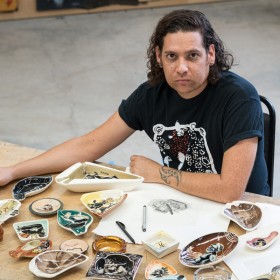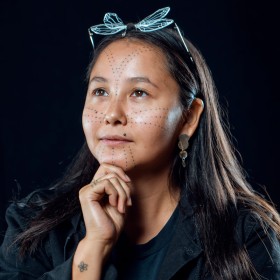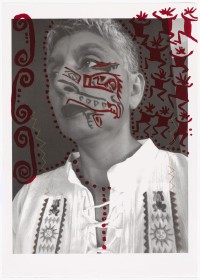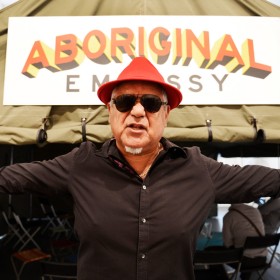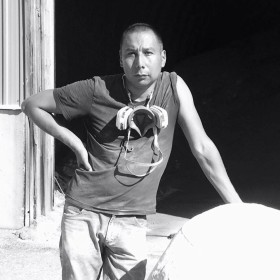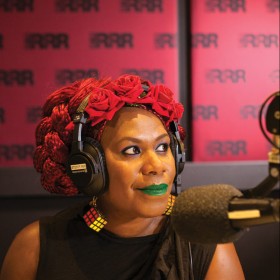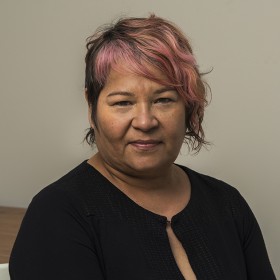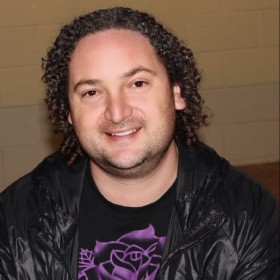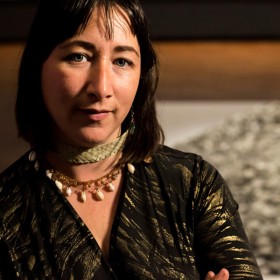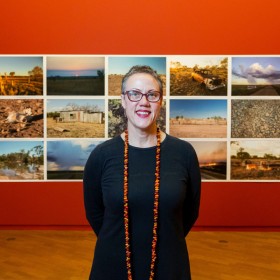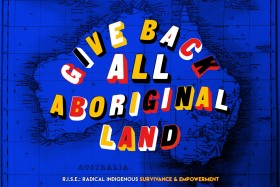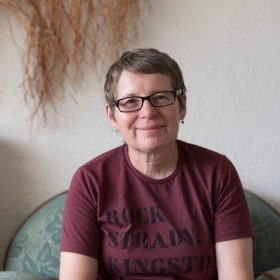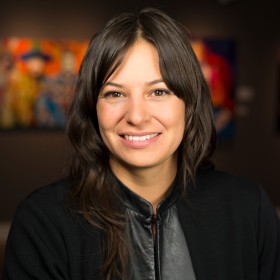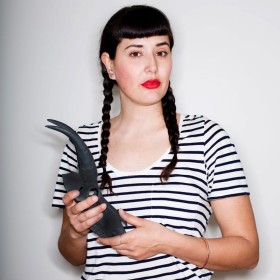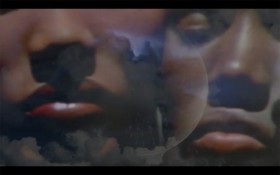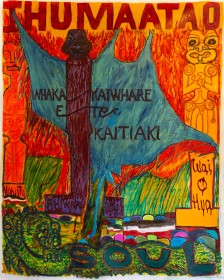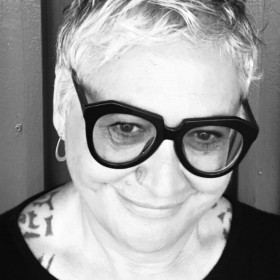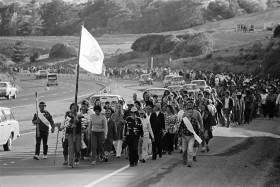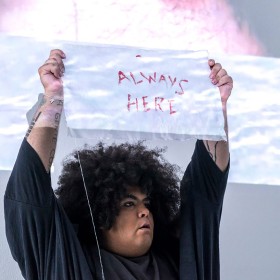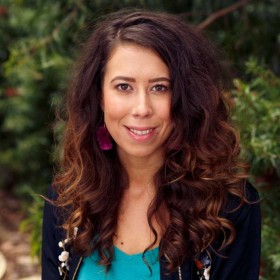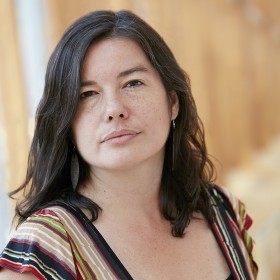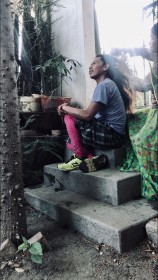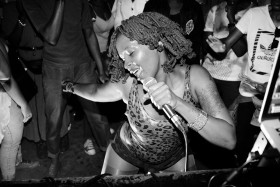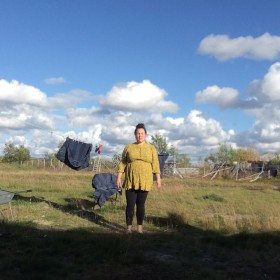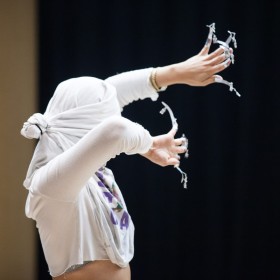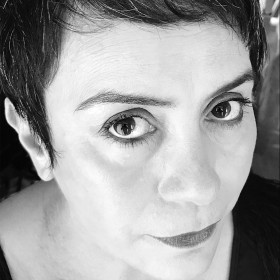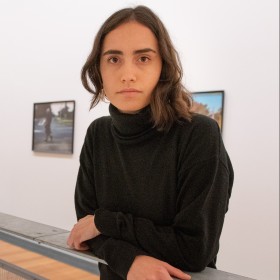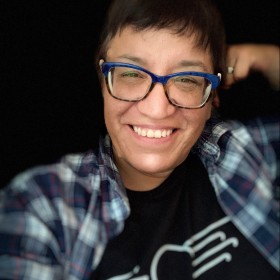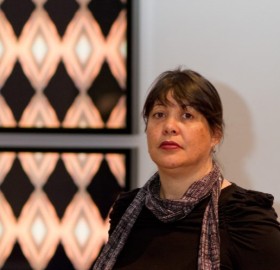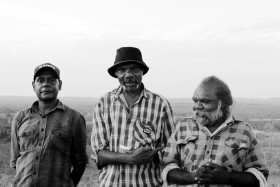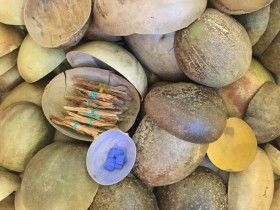- Visit
- Art & Artists
- Events & Learning
- Membership
- Donate
Saturday March 14 – Tuesday March 17, 2020
Sydney, Australia
Co-presented by AGO, Biennale of Sydney and the Canada Council for the Arts
aabaakwad 2020 NIRIN is an international four day gathering of Indigenous artists, curators and thinkers launching the 22nd Biennale of Sydney 2020.
Aabaakwad is an Indigenous-led conversation on Indigenous art by those who create, curate and write about it. This year gathers artists from over 24 First Nations and 12 countries.
aabaakwad 2020 NIRIN is a powerful international collaborative gathering set to launch the opening of 22nd Biennale of Sydney 2020 at a time in our world when a sense of urgency needs to be addressed through Indigenous philosophies and environmental knowledge systems, creativity and education. We join together to empower new thought and dialogue around broader issues of diaspora, borders, sovereignty, the decolonial, food/water sovereignty, languages, power of objects and restitution/repatriation and healing, trauma and transformation. These issues are central to aabaakwad and NIRIN.
aabaakwad 2020 NIRIN is a collaboration between aabaakwad founder Wanda Nanibush, an Anishinaabe curator of Indigenous Art at the AGO (Art Gallery of Ontario) and Wiradjuri artist/scholar Brook Andrew artist and artistic director of NIRIN, 22nd Biennale of Sydney 2020.
This year we are adding a day of live performance art works through the Biennial and an expanded music program.
Generously funded by the Canada Council for the Arts, Australia Council for the Arts, Stardust Arts and the Consulate General of Canada
THE GATHERING SCHEDULE
Saturday March 14
Opera House Opening
5:00 pm
Welcome to Country
5:15 pm
KEYNOTES
Wanda Nanibush (Anishinaabe)
Brook Andrew (Wiradjuri)
6:00 pm
PERFORMANCES
Pedro Wonaeamirri and collaborators (Milipurrula, Tiwi, Australia)
Bhenji Ra
Jota Mombaça
MUSIC
8:15 pm
Cris Derksen + band (Cree, Canada)
9:00 pm
Opera Bar Party
Sunday March 15
Cockatoo Island Performances
11:00 am
Gina Athena Ulysses (Haitian, USA)
Followed by a Q&A with Brook Andrew
12:00 noon
Ursula Johnson (Mi’kmaq, Canada)
Followed by a Q&A with Wanda Nanibush
1:00 pm
LUNCH (SELF PROVIDED)
2:00 pm
Dr. Léuli Eshrāghi (Sāmoan, Australia)
Followed by a Q&A with Namila Benson
3:00 pm
Q&A with Wanda Nanibush
4:00 pm
S.J Norman (Koori, Australia)
Demian DinéYazhi' (Nádleehí Diné, USA)
Joseph Pierce (Cherokee, USA)
Followed by a Q&A with Paschal Berry
aabaakwad NIRIN RADAR Boat Party - Sydney Harbour
5:30 pm
MUSIC/PERFORMANCE
DJ TBA
Musa N Nxumalo (South Africa)
SPOKEN WORD
Taqralik Partridge (Inuit, Norway)
Hannah Catherine Jones (UK)
Food and Drinks, Meet the artists
Monday March 16
Museum of Contemporary Art Conversations
11:00 am
Welcome to Country
11:15 am
Response and Responsibility
Brenda L. Croft (Gurindji/Malngin/Mudburra)
Stephen Gilchrist (Yamatji, Australia)
Ngahiraka Mason (Tūhoe, Māori, Hawai'i)
12:30 pm
LUNCH AT MCA
2:00 pm
Relations and Lineages
Clothilde Bullen (Wardandi [Nyoongar] and Badimaya [Yamatji], Australia)
Lori Blondeau (Saulteaux-Cree-Metis, Canada)
Wanda Nanibush (Anishinaabe)
3:00 pm
Land and Place
David Ruben Piqtoukun (Inuit, Canada)
Emily Karaka (Ngāi Tai ki Tāmaki, Ngati Hine, Ngāpuhi, Aotearoa)
Megan Tamati-Quennell (Te Atiawa, Ngati Mutunga, Ngai Tahu, Kati Mamoe, Waitaha, Aotearoa)
Dr. Marcia Langton, (Yiman and Bidjara, Australia)
4:00 pm
Break
4:30 pm
Collective Creation
Tennant Creek Brio (Waramungu, Kaytetye, Warlmunpa, Warlpiri, Alywarra, Australia)
Colectivo Ayllu (Afro-descendant and indigenous-descendant migrants of Abya Yala living in Spain)
Nigel Borell (Ngai Te Rangi and Ngati Ranginui, Aotearoa)
5:30 pm
Language of Land
Michael Belmore (Anishinaabe, Canada)
Julie Gough, (Trawlwoolway, Tebrikunna, Tasmania, Australia)
Hanahiva Rose (Ra’iātea, Huahine, Te Ātiawa, Ngāi Tahu, Ngāti Toa Rangatira)
Tuesday March 17
Museum of Contemporary Art Conversations
10:00 am
Welcome to Country
10:15 am
Poetics and Languages
Michelle Sylliboy (Mi’kmaq/L’nu, Canada)
Mayunkiki (Ainu, Japan)
Mylene Guay
11:00 am
A New Lens on Life
Hulleah Tsinhnahjinnie (Seminole-Muscogee-Navajo, USA)
Rosanna Raymond
John Miller (Ngā Puhi, Aotearoa)
Daniel Browning (Bundjalung and Kullilli, Australia)
12:00 noon
Digital Imaginaries
asinnajaq (Inuit, Canada)
Alan Michelson (Mohawk, USA)
Lisa Reihana (Ngāpuhi, Ngāti Hine, Ngāi Tū, Aotearoa)
Jaimie Isaac (Anishinaabe, Canada)
1:00 pm
LUNCH at MCA
2:00 pm
Transmotion and Presence
Nicholas Galanin (Tlingit/Unangax̂, USA)
Raven Chacon
Nici Cumpston
Niki Little
3:00 pm
Contending with the Contemporary
Candice Hopkins (Tlingit, Canada)
Biung Ismahasan (Bunun, Taiwan)
Rolande Souliere (Anishinaabe, Australia)
4:00 pm
Break
4:30 pm
Material Histories
Ursula Johnson
Tsēmā Igharas (Tahltan, Canada)
Kimberley Moulton (Yorta Yorta)
5:30 pm
Proppa Now
Vernon Ah Kee (Kuku Yalandji, Waanji, Yidinji and Gugu Yimithirr)
Richard Bell (Kamilaroi, Kooma, Jiman and Gurang Gurang)
Megan Cope (Quandamooka)
Tony Albert (Girramay, Yidinji and Kuku-Yalanji)
6:30 pm
CLOSING RESPONSES
Wanda Nanibush (Anishinaabe)
SPEAKERS
Tony Albert
Born 1981 in Townsville, Australia
Lives and works in Sydney, Australia
Tony Albert’s practice explores contemporary legacies of colonialism in ways which prompt audiences to contemplate elements of the human condition. Mining imagery and source material from across the globe, Albert draws on both personal and collective histories to explore the ways in which optimism might be utilised to overcome adversity. His practice is concerned with identity and the ascribing of social labels; unpacking what it means to judge and be judged in the absence of recognition or understanding.
Photo credit: Mark Pokorny
Vernon Ah Kee
Vernon Ah Kee’s conceptual text pieces, videos, photographs and drawings form a critique of Australian popular culture from the perspective of the Aboriginal experience of contemporary life. He particularly explores the dichotomy between Aboriginal and non-Aboriginal societies and cultures. Ah Kee’s works respond to the history of the romantic and exoticised portraiture of ‘primitives’, and effectively reposition the Aboriginal in Australia from an ‘othered thing’, anchored in museum and scientific records to a contemporary people inhabiting real and current spaces and time.
Ah Kee is a descendant of the Kuku Yalandji, Waanji, Yidindji, Koko Berrin and Gugu Yimithirr peoples. Born 1967 in Innisfail, North Queensland, Australia. Lives and works in Brisbane, Australia. Ah Kee’s work has been exhibited in a number of significant national and international exhibitions, including: ’unDisclosed’: 2nd National Indigenous Art Triennial’, National Gallery of Australia (2012); ‘SALTWATER: A Theory of Thought Forms’ 14th Istanbul Biennial (2015); ’Ideas of Barack’, National Gallery of Victoria (2011); ’Revolutions: Forms that turn’, the 16th Biennale of Sydney (2008); ‘Once Removed’, Australian Pavilion, Venice Biennale (2009); and ’Sakahàn: International Indigenous Art’, National Gallery of Canada (2013). Recent major group shows of his work include: 2018 Adelaide Biennial of Australian Art: Divided Worlds’, Art Gallery of South Australia (2018); ’Imaginary Accord’, Institute of Modern Art, Brisbane (2015); ‘GOMA Q’, Queensland Art Gallery/Gallery of Modern Art, Brisbane (2015); ‘When Silence Falls’, Art Gallery of New South Wales (2015-16); ‘Encounters’, National Museum of Australia (2015-16); ‘Brutal Truths’, Griffith University Art Gallery (2015-16); and ‘Everywhen: The Eternal Present in Indigenous Art from Australia’, Harvard Art Museums (2016). In 2020 Ah Kee presented a major new work as part of his solo exhibition ‘The Island’ at Campbelltown Arts Centre, Sydney. Ah Kee’s work is held in a number of major collections within Australia and overseas including the Tate Modern, London.
Asinnajaq
Asinnajaq is the daughter of Carol Rowan and Jobie Weetaluktuk. She is from Inukjuak, Nunavik and lives in Tiohtià:ke. Asinnajaq wrote and directed Three Thousand (2017) a short sci-fi documentary. She co-curated Isuma’s representaion in the ‘Canadian’ pavilion at the 58th Venice Biennale. Asinnajaq’s performance video Rock Piece (Ahuriri Edition) (2018) is currently touring in art galleries and film festivals around the world.
Colectivo Ayllu
Colectivo Ayllu / Migrantes Transgresorxs
Collective formed 2009 in Madrid, Spain
Lives and works in Madrid
Alex Aguirre Sánchez born 1973 in Quito, Ecuador
Leticia/Kimy Rojas born 1969 in Guayaquil, Ecuador
Francisco Godoy Vega born 1983 in Santiago, Chile
Lucrecia Masson born 1981 in Ombucta, Argentina
Yos Piña Narváez born 1984 in Caracas, Venezuela
Colectivo Ayllu is a collaborative research and artistic-political action group formed by migrants, people of color, and queer and sexual-gender dissidents from the ex-Spanish colonies. The collective proposes a critique of white supremacy and European colonial heteronormative ideology.
Image: Colectivo Ayllu, Enchaquiradx protected by huayruro, pionía, achiote and onoto (diptych), original lithograph produced in collaboration with Australian Print Workshop (APW)
Richard Bell
Richard Bell (b. 1953) lives and works in Brisbane, Australia. He works across painting, installation, performance and video. Bell is one of Australia’s most significant artists and his work explores the complex artistic and political problems of Western, colonial and Indigenous art production. He grew out of a generation of Aboriginal activists and has remained committed to the politics of Aboriginal emancipation and self-determination. In 2003 he was the recipient of the Telstra National Aboriginal Art Award. Bell is represented in most major Australian National and State collections, and has exhibited in a number of solo exhibitions at important institutions in Australia and America.
In 2013 he was included in the National Gallery of Canada’s largest show of International Indigenous art, Sakàhan, and at the Fifth Moscow Biennale of Contemporary Art. In 2014, Bell’s solo exhibition Embassy opened at the Perth Institute of Contemporary Arts, Perth. In 2015, Bell was a finalist in the Archibald Prize, presented a collaborative exhibition of new work with Emory Douglas at Milani Gallery, and exhibited his major work Embassy 2013-ongoing as part of Performa 15, New York City and the 16th Jakarta Biennale, curated by Charles Esche. Bell also premiered a body of new work as part of the Queensland Art Gallery/Gallery of Modern Art’s 8th Asia Pacific Triennial of Contemporary Art, Brisbane. In early 2016, BELL invites… an exhibition of Bell and work by friends and collaborators opened at the Stedelijk Museum SMBA, Amsterdam, and premiered a new sculptural commission as part of Sonsbeek 2016 at the Dutch Art Institute in Arnhem, Netherlands. Bell presented his Embassy as part of the 20th Biennale of Sydney, curated by Stephanie Rosenthal, at Cairns Indigenous Art Fair, the Institute of Modern Art, Brisbane, and most recently as part of the Jerusalem Show VIII. In 2017, Bell exhibited in The National: New Australian Art, a comprehensive survey of contemporary Australian art presented by the Museum of Contemporary Art, Art Gallery of New South Wales, and Carriageworks, Sydney. In 2018, he presented his solo exhibition Dredging up the Past at Gertrude Contemporary, Melbourne. In 2019, Bell took his Embassy project to the Venice Biennale as a collateral event and presented work at Padiglione d'Arte Contemporanea Milan. In 2021 Bell will be presenting a major solo exhibition and Embassy at the Tate Modern.
Photo credit: Toni Wilkinson
Michael Belmore
Michael Belmore employs a variety of materials and processes that at times may seem disjointed, yet, the reality is that together his work and processes speak about the environment, about land, about water, and what it is to be Anishinaabe. A graduate of the Ontario College of Art & Design, he completed his Masters of Fine Art at the University of Ottawa in 2019. Belmore’s work has been exhibited nationally and internationally and is represented in the permanent collections of various institutions and numerous private collections. His exhibitions include: Every. Now. Then: Reframing Nationhood at the Art Gallery of Ontario, Toronto, ON, Shapeshifting: Transformations in Native American Art at the Peabody Essex in Salem, MA and HIDE: Skin as Material and Metaphor at the National Museum of the American Indian – George Gustav Heye Centre in New York.
Seemingly small things, simple things, inspire his work; the swing of a hammer, the warmth of a fire, the persistence of waves on a shore. Through the insinuation of these actions, a much larger consequence is inferred.
Namila Benson
Born in Melbourne, Australia
Lives and works on the stolen lands and waters of the Wurundjeri and Woi Wurrung people of the Kulin Nations
Tolai Gunantuna (PNG)
Namila Benson works across multiple public and media platforms, skilfully guiding vital conversations that explore race, culture and identity politics through a visual arts lens. She contextualises dense topics on a range of issues to create engaging, decolonised and accessible conversations.
Photo credit: Ginger Van Handley
Lori Blondeau
Lori Blondeau works primarily in performance and photography. She is Cree/Saulteaux/Métis from Saskatchewan. Blondeau has exhibited and performed nationally and internationally including at the Banff Centre, Mendel Art Gallery, Saskatoon, Open Space, Victoria and FOFA, Montreal. In 2007, Blondeau was part of the Requickening project with artist Shelly Niro at the Venice Biennale. She is presently a Assistant Profess at the School of Art University of Manitoba.
Nigel Borell
Nigel Borell (of Pirirakau, Ngāti Ranginui, Ngāi Te Rangi, Te Whakatōhea Māori tribal descent) is Curator Māori Art at Auckland Art Gallery Toi o Tāmaki where his research in both customary and contemporary Māori art is produced for publication and exhibition-making. Recent curatorial projects include co-curating with Zara Stanhope The Moa Hunters by Areta Wilkinson, for 9th Asia Pacific Triennial, QAGOMA, Brisbane (2018) and The Māori Portraits: Gottfried Lindauer’s New Zealand, at the Auckland Art Gallery (2016) and deYoung Fine Arts Museum, San Francisco (2017). Current projects include the curatorium to Histōrias Indīgenas- Indigenous Histories at Museu de Art de (MASP), São Paulo, Brazil (2021). And the large survey exhibition and publication Toi tū Toi ora: Contemporary Māori Art to be presented at Auckland Art Gallery (2021). Collaborating with curator Megan Tamati-Quennell in the development of Nations to Nations (working title) a major Indigenous art exhibition for 2023 - 2024 which includes the development of an Indigenous reader and exhibition catalogue.
Borell participated in the First Nations Indigenous Curators Exchange programme (2015-2017) a partnership initiative of Creative New Zealand, Canada Council for the Arts and Australia Council for the Arts. Recent writing projects include, a contributing essay to Becoming our Future, a new publication engaged in the discourse of Indigenous curatorial practice from New Zealand, Canada and Australia (2020).
Clothilde Bullen
Clothilde joined the MCA in 2017 as Curator of Aboriginal and Torres Strait Islander Collections and Exhibitions. She is a Wardandi (Nyoongar) Aboriginal woman with English/French heritage. She commenced as Curator of Indigenous Art at the Art Gallery of Western Australia, Perth in January 2005, after previously managing a commercial Indigenous art gallery and remained there for over a decade.
Clothilde has curated a number of shows independently including Darkness on the Edge of Town in 2016 at Artbank, Sydney, and When the Sky Fell: Legacies of the 1967 Referendum at the Perth Institute of Contemporary Art this year. Clothilde has written for a number of contemporary arts publications including Sturgeon and Artlink, as well as published and contributed pieces to a range of catalogues, including in the recent Defying Empire catalogue from the National Gallery, Being Tiwi from the MCA, the Western Australian Indigenous Art Awards catalogue and Raised by Wolves for PIAF.
In 2019, Clothilde co-curated The National 2019: New Australian Art at the MCA. She is the curator of the 2018 exhibition Compass: MCA Collection, which considers the trajectories of Indigenous and non-Indigenous women practices in dialogue with one another. Clothilde is a co-curator of John Mawurndjul: I am the old and the new, the MCA’s exhibition of the works of the master bark painter developed and co-presented with the Art Gallery of South Australia, in association with Maningrida Arts & Culture.
Clothilde was on the Inaugural Advisory Committee for the Wesfarmers and NGA Indigenous Arts Leadership Program and is an Alumni member of the British Council Accelerate Scholarship for Indigenous Leadership in the Arts.
Megan Cope
Megan Cope is a Quandamooka (North Stradbroke Island in South East Queensland) artist. Her site-specific sculptural installations, video work and paintings investigate issues relating to identity, the environment and mapping practices.
Cope’s work often resists prescribed notions of Aboriginality, and examines psychogeographies that challenge the grand narrative of ‘Australia’ and our sense of time and ownership in a settler colonial state. These explorations result in various material outcomes.
In 2020, Cope is presenting newly-commissioned work at the 2020 Adelaide Biennial of Australian Art: Monster Theatres. She will also be undertaking a residency at Canberra Glassworks, which will result in a solo exhibition of new work. New work will also appear in the exhibition, OCCURRENT AFFAIR: proppaNOW at the University of Queensland Art Museum.
In 2018 Cope undertook a residency in Paris with the Australian Print Workshop for a project titled
French Connections, which resulted in an exhibition at the Australian Print Workshop in 2019, and a tour to Mosman Art Gallery in 2020.
In 2018, she also completed several public art projects including Weelam Ngalut (our place) commissioned for the Monash University Museum of Art’s Public Art Walk at Monash University. Her large scale sculptural installations were curated into three national survey exhibitions,
The National (2017) at the Art Gallery of New South Wales, Defying Empire: 3rd National Indigenous Art Triennial (2017) at the National Gallery of Australia and Sovereignty (2016) at the Australian Centre for Contemporary Art, Melbourne.
Cope’s work has been exhibited in Australia and internationally including at the Queensland Art Gallery/Gallery of Modern Art; Art Gallery of New South Wales; Gold Coast City Art Gallery; MONA FOMA, Hobart; ARC Biennial, Brisbane; Cairns Regional Art Gallery; Koorie Heritage Trust, Melbourne; City Gallery, Wellington, New Zealand; Para Site Contemporary Art Space, Hong Kong; Careof Art Space, Milan; the Australian Embassy, Washington and Next Wave Festival, 2014. In 2015 Cope’s work was curated into an exhibition at Musées de la Civilisation in Québec, Canada, which also acquired her work for their permanent collection.
Megan Cope is a member of Aboriginal art collective proppaNOW.
She is represented by Milani Gallery, Brisbane.
Photo credit: Courtesy of the National Gallery of Australia
Brenda L Croft
Brenda L Croft is from the Gurindji/Malngin/Mudburra peoples from the Victoria River region of the Northern Territory of Australia, and Anglo-Australian/German/Irish/Chinese heritage. She has been involved in the Australian First Nations and broader contemporary arts and cultural sectors as an artist, arts administrator, curator, educator and consultant for over three decades.
Brenda lives and works in Canberra on Ngambri/Ngunawal/Ngunnawal country where she is is Associate Professor, Indigenous Art History and Curatorship at the Centre for Art History and Art Theory, School of Art and Design, College of Arts & Social Sciences, Australian National University. She is completing her doctoral research through the National Institute for Experimental Arts, UNSW Art + Design.
Brenda’s transdisciplinary artistic practice encompasses critical performative Indigenous auto-ethnography, Indigenous Storywork and historiography, representation and re/memoriying through multi-media work. Her creative practice draws extensively on personal and public archives and her work is represented in major public and private collections in Australia and overseas.
Cris Derksen
Juno nominated Cris Derksen, originally from Northern Alberta Canada is an Internationally respected Indigenous Cellist/ Composer. As a composer she has her foot in many worlds working in Choral, Symphonic, Chamber, Film, Theatre and Dance, with a new commission from the Calgary Philharmonic Symphony Orchestra premiering in 2020. As a performer Derksen performs Nationally and Internationally. Recent destinations include Hong Kong, Australia, Mongolia, Europe, Mexico and a whole lot of Canada; the place Derksen refers to as home.
Demian DinéYazhi´
Demian DinéYazhi´
Born 1983 in Gallup, New Mexico
Lives and works in the ancestral lands of the Diné, Chinook, Clackamas, Wasco, Multnomah, Cowlitz, Kathlamet, Tualatin, Kalapuya, Molalla, and many other tribes
Demian DinéYazhi´ is a transdisciplinary Indigenous Diné Nádleehí artist, poet, and curator. They are a survivor of attempted European-inspired genocide, forced assimilation, sexual and gender violence, capitalist sabotage, and hypermarginalisation in a colonised country. They live and work in a post-post-apocalyptic world, unafraid to fail.
Image: Demian DinéYazhi´, GIVE BACK ALL ABORIGINAL LAND, 2020, digital print, dimensions variable. Courtesy the artist
Dr. Léuli Eshrāghi
Born 1986 in Yuwi Country, Australia
Lives and works in Garrmalang / Darwin, Australia and Tiohtià:ke / Mooniyang / Montréal, Canada
Sāmoan
Dr Léuli Eshrāghi, Sāmoan artist, curator and researcher, intervenes in display territories to centre Indigenous presence and power, sensual and spoken languages, and ceremonial-political practices. Through performance, moving image, writing and installation, ia engages with Indigenous possibility as haunted by ongoing militourist and missionary violences that erase faʻafafine-faʻatama from kinship structures. Ia contributes to growing international critical practice across the Great Ocean and North America through residencies, exhibitions, publications, teaching and rights advocacy.
Image: Léuli Eshrāghi, tagatanuʻu, 2017-ongoing, sand, coconuts, macadamia nuts, coconut water, bowls, books, cushions, coconut scraping stool, live performance, dimensions variable. Installation view (2019) at Sharjah Biennial 14: Leaving the Echo Chamber, Sharjah. Partially commissioned by the Sharjah Art Foundation. Courtesy the artist and Sharjah Art Foundation.
Nicholas Galanin
Born 1979 in Sitka, Alaska, USA
Lives and works in Sitka
Nicholas Galanin’s work engages contemporary culture from his perspective, rooted in connection to land. He embeds incisive observation into his work, investigating intersections of culture and concept in form, image and sound. Galanin's works embody critical thought as vessels of knowledge, culture and technology – inherently political, generous, unflinching, and poetic.
Image: Nicholas Galanin, Tsu Heidei Shugaxtutaan Part I [We Will Again Open This Container of Wisdom That Has Been Left In Our Care Part I], 2006 (video still) single channel video, 4:37 mins, Courtesy the artist
Julie Gough
Julie Gough is a Trawlwoolway (Tasmanian Aboriginal) artist, writer and a curator of Indigenous Cultures at the Tasmanian Museum and Art Gallery. Her Briggs-Johnson family have lived in the Latrobe region of North West Tasmania since the 1840s with Tebrikunna their Traditional Country, in far north eastern Lutruwita (Tasmania). Gough’s art practice often involves uncovering and re-presenting conflicting and subsumed histories, many referring to her family's experiences as Tasmanian Aboriginal people.
Since 1994 Julie has exhibited in more than 130 exhibitions that include: TENSE PAST, solo survey exhibition, Tasmanian Museum and Art Gallery; Divided Worlds, Adelaide Biennial of Australia Art, 2018; Defying Empire, National Gallery of Australia, 2017 and touring; THE NATIONAL, MCA, 2017; With Secrecy and Despatch, Campbelltown Arts Centre, 2016; undisclosed, National Gallery of Australia, 2012; Clemenger Award, National Gallery of Victoria, 2010; Biennial of Sydney, 2006; Liverpool Biennial, UK, 2001;Perspecta, AGNSW, 1995. Gough holds a PhD from the University of Tasmania (Visual Arts, 2001), a Masters degree (Visual Arts) University of London, Goldsmiths College (1998), and Bachelor degrees in Visual Arts (Curtin University), Prehistory and English literature (University of West Australia). In 2018 a monograph on her art: Fugitive History, was published by UWA Press, and her short fictionella: Shale, was produced by A Published Event. Gough’s artwork is held in most Australian state and national gallery collections.
Photo credit: Lucy Parakhina
Candice Hopkins
Candice Hopkins is a curator and writer originally from Whitehorse, Yukon. She is Senior Curator of the 2019 and 2021 editions of the Toronto Biennial of Art and was a co-curator of the Canadian Pavilion at the 58th Venice Biennale, featuring the videos of the Igloolik-based media collective, Isuma. Hopkins was also co-curator of the SITE Santa Fe biennial, Casa Tomada and was a curator for documenta 14 in Athens, Greece and Kassel, Germany and a co-curator of the major exhibitions Sakahàn: International Indigenous Art, Close Encounters: The Next 500 Years, and the 2014 SITE Santa Fe biennial, Unsettled Landscapes. Her writing is published widely and her recent essays and presentations include "The Gilded Gaze: Wealth and Economies on the Colonial Frontier” for the Documenta 14 Reader; Outlawed Social Life” for South as a State of Mind; and “Sounding the Margins: A Choir of Minor Voices” at Small Projects, Tromsø, Norway. She has lectured internationally including at Yale University, Witte de With, Tate Modern, Dak’Art Biennale, Artists Space, Tate Britain and the University of British Columbia. She is the recipient of numerous awards including the Hnatyshyn Foundation Award for Curatorial Excellence in Contemporary Art and the 2016 the Prix pour un essai critique sur l’art contemporain by the Foundation Prince Pierre de Monaco. She is a citizen of Carcross/Tagish First Nation.
Tsēmā Igharas
Igharas is an award-winning interdisciplinary artist and a member of the Tahltan First Nation. She uses Potlatch methodology to create conceptual artwork and teachings influenced by her mentorship in Northwest Coast Formline Design at K’saan, her studies in visual culture and time in the mountains. Tsēmā has shown and performed in various places in Canada and internationally presenting her work that connects materials to mine sites and bodies to the land.
Jaimie Isaac
Jaimie Isaac is the Curator of Indigenous and Contemporary Arts at the Winnipeg Art Gallery, an interdisciplinary artist, and member of Sagkeeng First Nation in Treaty 1 Territory. Isaac holds a degree in Art History From University of Winnipeg and a Masters of Arts from the University of British Columbia, with the thesis focus on Decolonizing Curatorial Practice. Exhibitions curated at the Winnipeg Art Gallery are subsist, ᐃ (co-curated) Behind Closed Doors, organic, Insurgence Resurgence (co-curated) and Vernon Ah Kee: cantchant, Boarder X (National tour), We Are On Treaty Land, and Quiyuktchigaewin; Making Good. Isaac co-founded of The Ephemerals Collective, which was long-listed for the 2017 and 2019 Sobey Art Award. Jaimie collaborated with an artistic team on a public sculpture at the Forks called Nimama at South Point path: Niizhoziibean and collaborated on a public art project, Cyclical Motion: Indigenous Art & Placemaking. Jaimie has contributed articles and features for Art + Wonder, C Magazine, Bordercrossings, and essays for exhibition catalogues; Insurgence Resurgence, Boarder X, Close Encounters: The Next 500 Years, and unsacred, and contributed in collections of writing within The Land We Are Now: Writers and Artists Unsettle the Politics of Reconciliation, West Coast Line 74 and Public 54: Indigenous Art: New Media and the Digital Journal. Jaimie was co-faculty for the Wood Land School at Plug In Summer Institute in 2016. She is the Advisory Committee for the Winnipeg Art Gallery, Manitoba Museum and is on the board of directors for Bordercrossings Magazine. Recently, Jaimie received an honouree for Leaders of Tomorrow from the Manitoba Museum 50th Tribute Awards.
Ursula Johnson
Ursula Johnson is from the Mi’kmaw Eskasoni First Nation and an alumna of the Nova Scotia College of Art & Design University (2006). Johnson’s interdisciplinary practice is based primarily in performance and installation, often using sound and at times sculpture. She is quoted as saying that she “changes mediums based on who I am talking to and the conversation I am inciting”.
Johnson has been shortlisted for the Salt Spring National Art Prize (2015) and the Nova Scotia Masterworks Award (2016) recipient of the Hnatyshyn Foundation Reveal Indigenous Art Award (2016), Recipient for the Sobey Art Award (2017) and Recipient for the NS Masterworks Award (2019).
Ursula has exhibited work nationally at various university art galleries, provincial museums, artist run centres and festivals. She has also shown work internationally in Athens, Venice, Houston, New York, Idyllwyld, Guangzhou, Shenzhen with upcoming visits to Sydney, Bethlehem, Mexico City, Berlin and Trømso.
Hannah Catherine Jones
Born 1987 in Doncaster, England
Lives and works in London, England
Bajan
Hannah Catherine Jones (aka Foxy Moron) is a London-based artist, scholar, multi-instrumentalist, radio presenter and DJ (BBC Radio 3 - Late Junction, NTS - The Opera Show), composer, conductor and founder of Peckham Chamber Orchestra – a community project established in 2013. Jones is currently an AHRC DPhil scholar at Oxford University for which the ongoing body of work The Oweds will be presented as a series of live and recorded audio-visual episode-compositions using disruptive sound as a methodology of institutional decolonisation.
Image: Hannah Catherine Jones, Owed to Diaspora(s), (video still), 2019. Courtesy the artist
Emily Karaka
Born 1952 in Auckland, New Zealand
Lives and works in Auckland
Emily Karaka is of Ngati Te Ahi Waru bloodlines with whakapapa to Puketapapa and Ihumatao from her father John Mita Karaka, named after his Great Grandfather Mita Karaka who went to England with the Maori King to address Treaty of Waitangi concerns in 1914. Karaka has painted and exhibited her works for 40 years and worked since 1992 for her other iwi Ngai Tai ki Tamaki addressing its environmental concerns and Treaty of Waitangi claims. Her paintings address political and environmental issues and Maori values.
Mayunkiki
Born 1980 in Hokkaido, Japan
Lives and works in Hokkaido
Mayunkiki is a member of ’Marewrew’, a women’s vocal group whose activities centre around the rebirth and passing on of the traditional Ainu song Upopo – a practice rooted in rhythmical patterns and the signature style of singing in a natural trance-like chorus. Mayunkiki also participates in several creative projects related to Ainu culture as an adviser / singer.
Image: Mayunkiki with Sinuye in ethnic clothes of Ainu, 2018. Photograph: Hiroshi Ikeda
Misheck Masamvu
Born 1980 Mutare, Zimbabwe
Lives and works in Harare, Zimbabwe, and Johannesburg, South Africa
Working predominantly as a painter and sculptor, Misheck Masamvu describes his works as ‘mutants’ that oscillate between abstraction and figuration. Masamvu’s practice is a battle against the forced ideology of government and the breakdown of the pursuit of humanity. His works are understood as marks of existence, pointing not only to the realities of his lived experience but also to mental and psychological space, where each layer of paint, or brush stroke on the canvas proposes a search to resolve conflicted experiences or decisions.
Image: Misheck Masamvu, Unaccounted Histories, 2018, Oil on Canvas, 260 x 200 cm. Courtesy of the artist and the Goodman Gallery.
Ngahiraka Mason
Ngahiraka Mason is an independent cultural producer, curator, critic, and visual historian with research and curatorial interests in the material culture and histories of Polynesian peoples and community relationships with museums and collections. Mason is the former Indigenous Curator, Māori Art at Auckland Art Gallery Toi O Tamaki, New Zealand. Her exhibitions and publications focus on historical, modern, and contemporary art. Recent projects and research interests include Wananga | Wanana (2019) at Bishop Museum, Honolulu (2019); Honolulu Biennial: Middle of Now/Here, the inaugural Honolulu Biennial (2017); and the International touring exhibition Gottfried Lindauer’s New Zealand (2014–17). Mason is the New Zealand representative for the Aotearoa delegation to FestPac 2020 in Honolulu Hawai’i, where she lives and works.
Alan Michelson
Alan Michelson is an internationally recognized New York-based artist, curator, writer, lecturer and Mohawk member of the Six Nations of the Grand River.
For over thirty years, he has been a leading practitioner of a socially engaged, critically aware, site-specific art grounded in local context and informed by the retrieval of repressed histories. Sourcing from both Indigenous and western culture, he works in a varied range of media and materials. His work has been widely shown and recent exhibitions include Wolf Nation, a solo show at the Whitney Museum of American Art; Nature’s Nation: American Art and Environment at the Princeton University Art Museum; and Indicators: Artists on Climate Change at Storm King Art Center.
He is the recipient of several awards, including the Macgeorge Fellowship, University of Melbourne; Native Arts and Cultures Foundation Artist Fellowship; and NEA Visual Artists Fellowship. His work is in the permanent collections of the Whitney Museum of American Art, National Gallery of Canada, the Smithsonian National Museum of the American Indian, and other museums.
His diverse practice includes award-winning public art, and Mantle, his permanent, large-scale monument honoring Virginia’s Indian nations was dedicated at the capitol in Richmond in 2018.
Michelson is co-founder and co-curator, with the Vera List Center for Art and Politics at the New School, of the groundbreaking Indigenous New York series.
John Miller
Born 1950 in Auckland, Aotearoa / New Zealand
Lives and works in Auckland and other areas throughout Aotearoa / New Zealand
During his long career in photography, John Miller has concentrated on documenting anti-war, civil rights, anti-apartheid, anti-nuclear and Maori political protests. Miller worked as a photographer for the student newspaper Craccum in 1972 and became focused on the various protest movements of the era. He documented movements such as Nga Tamatoa, The Polynesian Panthers, the birth of the New Zealand Maori Artists and Writers Society (Ngā Puna Waihanga) and later the 1975 Maori Land March and the Bastion Point occupation, 1977-1978. Miller’s photographs have featured in many exhibitions and publications including the seminal publication Maori Sovereignty by Donna Awatere, and Hikoi: Forty years of Maori Protest.
Image: John Miller. Maori Land March on Porirua – Wellington Motorway, New Zealand. October, 1975.
Jota Mombaça
Born 1991 in Natal, Brazil
Lives and works between Fortaleza, Brazil; Lisbon, Portugal and Berlin, Germany
Jota Mombaça is an interdisciplinary artist whose work derives from poetry, critical theory and performance. The sonic and visual matter of words plays an important role in their practice, which often relates to anti-colonial critique and gender disobedience. Through performance, visionary fiction and situational strategies of knowledge production, they intend to rehearse the end of the world as we know it and the figuration of what comes after we dislodge the Modern-Colonial subject off its podium.
Image: How old is suffering? Jota Mombaça, Performance 2018. Photo by Anna Cerato.
Kimberley Moulton
Kimberley Moulton is a Yorta Yorta woman, curator and writer and Senior Curator South Eastern Aboriginal Collections at Museums Victoria. Kimberley has worked in curatorial roles at Museums Victoria for over ten years, curating numerous exhibtions with Victorian Koorie Community and was lead curator for Mandela: My Life, an exhibition on Nelson Mandela at Melbourne Museum 2018.
Her practice works in de-colonial methodology and the intersection of research, community driven projects, contemporary art and historical cultural material which extends to both the museum and contemporary art space. Kimberley has written extensively for art publications nationally and internationally and held research, curatorial and writing fellowships across Europe, UK, South Asia and America. Alongside her museum practice Kimberley has independently curated shows in various art museums across Australia and the USA and in 2019 Kimberley was the recipient of the Power Institute National Indigenous Art Writing Award. Kimberley is co-editor for Artlink Indigenous edition 40.2 in 2020 and on the board of directors and deputy chair for Shepparton Art Museum
Photo credit: James Henry
Wanda Nanibush
Wanda Nanibush is an Anishinaabe-kwe image and word warrior, curator and community organizer from Beausoleil First Nation. Currently Nanibush is the inaugural curator of Indigenous art and co-head of the Indigenous + Canadian art department at Art Gallery of Ontario (AGO). Nanibush is the founder of aabaakwad.
Her current AGO exhibition, Rebecca Belmore Facing the Monumentalis touring internationally. Nanibush has a masters of visual studies from University of Toronto where she has taught graduate courses. On top of many catalogue essays Nanibush has published widely on Indigenous art, politics, history and feminism and sexuality.
S.J Norman
Born 1984 in Sydney, Australia
Lives and works between Kulin Country / Melbourne, Australia; Berlin, Germany; and New York, Unites States
S.J Norman is a cross-disciplinary artist and writer. He is a non-binary transmasculine person and a diasporic Koori of Wiradjuri descent, born on Gadigal land. Norman's work centres the corporeal and the inter-corporeal: he inhabits and disrupts the prevailing vocabularies of performance as a queer/ed Indigenous body, addressing that body as both site and material. He utilises ephemeral, process-based and long-durational practices as a means of antagonising the prevailing economies of colonial spectatorship and capital value, as well as a means to excavate and elevate embodied knowledges.
Image: S.J Norman, Magna Mater, 2020 (video stills). 12-channel video. Courtesy the artist
Musa N. Nxumalo
Born 1986 in Soweto, South Africa
Lives and works in Johannesburg, South Africa
Musa N. Nxumalo received his introduction to photography at the Market Photo Workshop in Johannesburg, along with Sabelo Mlangeni and the late Thabiso Sekgala who together are often associated with the new generation of contemporary South African photographers. He completed the Foundation and Intermediate Courses at Market Photo Workshop between 2006 and 2008, and has since participated in several workshops and master classes. In 2015, he was nominated for the prestigious First Book Award by the African Literature Association. Other awards he has received include the Edward Ruiz Mentorship in 2008, second prize at the MTN CITY Festival in 2009 and first prize in Visual Art at the ImpACT Awards, South Africa in 2010.
Image: Musa N. Nxumalo_Moonchild Sanelly -Anthopology of Youth_2016_Giclee Print on Hahnemuhle Photo Rag_56 x 84 cm_Ed.1 of 6 + 2 AP_HR_Image courtesy of SMAC Gallery, artwork copyright Musa N. Nxumalo
Taqralik Partridge
Born 1975 in Montreal, Canada
Lives and works in Kautokeino, Sápmi / Norway and Ottawa, Canada
Taqralik Partridge is a textile artist, writer, and spoken word poet originally from Kuujjuaq, Nunavik. She is currently based in Guovdageaidnu, Sápmi, Norway.
Joseph Pierce
Joseph M. Pierce is Associate Professor in the Department of Hispanic Languages and Literature at Stony Brook University. His research focuses on the intersections of kinship, gender, sexuality, and race in Latin America, 19thcentury literature and culture, queer studies, Indigenous studies, and hemispheric approaches to citizenship and belonging. He is the author of Argentine Intimacies: Queer Kinship in an Age of Splendor, 1890-1910 (SUNY Press, 2019) and co-editor of Políticas del amor: Derechos sexuales y escrituras disidentes en el Cono Sur (Cuarto Propio, 2018) as well as the forthcoming special issue of GLQ, “Queer/Cuir Américas: Translation, Decoloniality, and the Incommensurable.” His work has been published recently in Revista Hispánica Moderna, Critical Ethnic Studies, The Art Newspaper, and has also been featured in Indian Country Today. Along with SJ Norman (Koori, Wiradjuri descent) he is co-curator of the performance series Knowledge of Wounds. He is a citizen of the Cherokee Nation.
Bhenji Ra
Born 1990 in Warrang / Sydney, Australia
Lives and works in Warrang / Sydney
Club Ate is a collective formed in 2014 by multi-form artists Justin Talplacido Shoulder and Bhenji Ra. Their practice traverses video, performance and club events with an emphasis on community activation. Collaborating with members of the queer Asia-Pacific diaspora in Australia and the Philippines, the collective are invested in creating their own future folklore.
For the 22nd Biennale of Sydney, Filipina Australian artist Bhenji Ra engages Tausug Elder and Pangalay master Sitti Obeso from southern Philippines in performative conversation at the Powerhouse Museum. Bleeding the lines between ocean and land, traditional and contemporary, the original and the diasporic body, this exchange between teacher and student is a generous sharing of a relationship sustained by periodical visits to home country, the sharing of personal ephemera, and online messages across the Pacific Ocean. The series of performance lectures offers an alternative mode of cultural pedagogy that avoids reductive notions around performing culture and learning repertoire.
Image: Bhenji Ra, Talking Bodies, 2019. Performance for Late Night Library (2019) at Surry Hills Library. Photograph: Katy Green Loughrey
Lisa Reihana
Born 1964 in Auckland, Aotearoa / New Zealand
Lives and works in Auckland
Ngāpuhi, Ngāti Hine, Ngāi Tū
Lisa Reihana is a multi-disciplinary artist whose practice spans film, sculpture, costume, body adornment and photography. Since the 1990s she has significantly influenced the development of contemporary art and contemporary Māori art in Aotearoa / New Zealand. Her art making is driven by a powerful connection to community, which informs her collaborative working method described as kanohi ki te kanohi (face to face). Influenced by Indigenous filmmaking, her technically ambitious and poetically nuanced work disrupts gender, time, power, and representational norms.
Photo credit: James Pinker
Hanahiva Rose (Ra’iātea, Huahine, Te Ātiawa, Ngāi Tahu, Ngāti Toa Rangatira)
Hanahiva Rose is the assistant curator of contemporary art and collections at the Govett-Brewtser Art Gallery in Ngāmotu, Aotearoa. Previously she has worked as an adviser at Manatū Taonga Ministry for Culture and Heritage, as research assistant at the Museum of New Zealand Te Papa Tongarewa, and as research assistant and curatorial intern on Oceania at the Royal Academy of Arts, London.
Hanahiva's most recent curatorial project, This is a library, is on display at Enjoy Contemporary Art Space until 18 April 2020. The exhibition brings together works by Teuane Tibbo, drawn from private and public collections, with new commissions by Christina Pataialii, Salome Tanuvasa and Claudia Jowitt.
Hanahiva is regularly published for her research into Māori and Pacific art practices. Recent and upcoming publications include “Aotearoa Moana Nui A Kiwa Weavers 1983–1993,” ATE Journal of Māori Art (2020); “Memories Carved in Relief: The Art of Brett Graham,” Art News (2020); and “Tauira: Mata Aho’s many ways of knowing,” Embodied Knowledge/Can Tame Anything (Wellington: The Dowse Art Museum, 2019).
Hanahiva is a current participant in the Creative New Zealand First Nations Curators Exchange Programme and the HANDSHAKE Craft Writers' Programme.
David Ruben
David Ruben is a carver and sculpture using primarily stone to interpret the legends and mythology of his people since he started on this path of expression in 1972. Born in Paulatuk, Northwest Territories, Canada in 1950, his recollections of living in a nomadic and semi-primitive existence have instilled a deep and lasting love for the raw and rugged beauty of land and nature.
An unwelcome removal from those familiar surroundings at about age 5 to attend residential school generated a tumultuous upheaval of identity. Those experiences are deeply ingrained in several of his works, both subtle and dramatic.
With time, the direction of his work took an immense leap into Inuit mythology. New and old stories David collects are embodied in his unique style. The conception, planning and execution of sculpting is a ritual for him; energized by a profoundly abstract imagination.
David Ruben has exhibited internationally and been featured in several documentaries.
His works are in private collections, museums and galleries around the world, and he continues to actively exhibit by invitation. His personal and cultural stories are often presented to audiences ranging from school children to indigenous art enthusiasts.
Rolande Souliere
Multi-media artist, Rolande Souliere is best known for her large-scale site specific immersive installations created from caution and street barrier tape to address how colonial infrastructures define, mark and control space and the inhabitants within them.
For a decade, Souliere has been working with material and metaphors of the road to address how systems, namely political and cultural systems inform, construct and impact personal and collective histories in contemporary society.
Utilising repetitive strategies of wrapping, binding and layering, Souliere’s artworks incorporate reflective road signage, automobile headlights and brake lights, GPS systems, construction vests and delineators. These universal materials are stripped from their usual contexts, manipulated and repurposed into dynamic installations that discuss narratives that shape our understanding of infrastructural intervention, economic expansion and growth with the oncoming of colonial settlement.
Souliere is a member of Michipicoten First Nation, born in Toronto, Canada and is an Australian citizen. Souliere became an artist after moving to Sydney in the late 1990s. She has a PhD from Sydney College of the Arts, University of Sydney. A selection of Souliere’s international solo and group shows include Frequent Stopping III, IV and V (2018), Form and Content, Part I and II (2019) (2018), Indigenous Womxn Banner Project (2019), Future Memories (Present Tense) (2017), Living Systems No. 2 (2017) and the touring cross Canada exhibition Beat Nation (2012-2014). Her public art commissions include Mediating the Treaties (2017-2018) commissioned by The City of Winnipeg, Frequent Stopping III for How far do you travel? (2018) with Translink BC and CAG, Vancouver and Bringing Back Wabakinine (2015) commissioned by City of Toronto.
Michelle Sylliboy
Interdisciplinary artist and poet Michelle Sylliboy (Mi’kmaq/L’nu) was born in Boston, Massachusetts and raised on her traditional L'nuk territory in We'koqmaq, Cape Breton. While living on the traditional, unceded territories of the Musqueam, Squamish, and Tsleil-Waututh Nations, Sylliboy completed a BFA at Emily Carr University of Art + Design, and a Masters in Education from Simon Fraser University. She is currently a PhD candidate in Simon Fraser University’s Philosophy of Education program, where she is working to reclaim her original written komqwej’wikasikl language. Her collection of photography and Mi’kmaq (L’nuk) hieroglyphic poetry, Kiskajeyi—I Am Ready, was published by Rebel Mountain Press in 2019.
Megan Tamati-Quennell
Megan Tamati-Quennell (Te Ātiawa, Ngāti Mutunga, Kāti Māmoe, Ngāi Tahu) is leading curator and writer of modern & contemporary Māori & Indigenous art, a field she has worked in for three decades.
Her specialist interests include Māori modernism, 1945-1973, Mana Wāhine Māori; the Māori women artists of 1970s-90s, The Māori Internationals; the urban avant-garde Māori artists of New Zealand's bicultural era, Global Indigenous art, Indigenous art curatorial praxis and the intersection of modern and contemporary art with Indigenous art.
Megan currently holds two curatorial positions; Curator Modern & contemporary Māori & Indigenous art at Te Papa and Associate Indigenous Curator, Contemporary Art | Kairauhī Taketake Toi Onāianei at the Govett Brewster Art Gallery and divides her time with each role, between Wellington and New Plymouth.
Tennant Creek Brio
Lives and works in Tennant Creek, Australia
The Tennant Creek Brio is an artist collective based in the Barkly regional town of Tennant Creek, (population 3,200) located in Warumungu country in the Northern Territory. The collective began in 2016 as an Aboriginal men’s art therapy program through Anyinginyi Aboriginal Health Organisation to help men with issues of alcohol and substance misuse. Under the direction of artist Rupert Betheras and supported by fellow artistS Fabian Brown, Joseph Williams and the more senior David Duggie, the collective quickly gained traction amongst local men. The collective soon grew its core membership to include Marcus Camphoo, Simon Wilson, Lindsay Nelson, Clifford Thompson, and Matthew Ladd alongside several occasional members and fellow travellers.
Image: From the left to the right / Rupert Batheras, Clifford Thompson, Fabian Brown and Nelson Lindsay / Photograph: Copyright © Giulia Picasso
Gina Athena Ulysses
Born 1966 in Pétion-Ville, Haiti
Lives and works in Connecticut, United States
Gina Athena Ulysse is a feminist interdisciplinary artist whose approach considers manifestations of power and vulnerability in unprocessed horrors of the past. With her method / praxis of rasanblaj (gathering ideas, things, people and spirits) she confronts the visceral in the structural. Her work reorients notions of aesthetics by pursuing beauty in the simplest of natural things.
Image: Gina Athena Ulysses, The Wall, 2019, Photograph: GAU, Courtesy of the artist
Pedro Wonaeamirri
Born 1974 in Melville Island, Australia
Lives and works in Melville Island
Steeped in Tiwi tradition, Pedro Wonaeamirri’s contemporary art practice has its foundations in Jilamara – design derived from ceremonial body painting, also applied to tutini mourning poles, tunga (folded bark bags) and associated ritual objects made for ceremony and Tiwi yoi (dance).
Image: Pedro Wonaeamirri, Tutini, 2019, natural ochres on ironwood. Courtesy the artist, Jilamara Arts and Craft and Alcaston Gallery, Melbourne. Copyright © Pedro Wonaeamirri. Photograph: Will Heathcote
Sponsored by
Sponsored by
Presented in partnership with the Canada Council for the Arts.
Presented in partnership with the Canada Council for the Arts.
ABOUT CANADA COUNCIL FOR THE ARTS
The Canada Council for the Arts is Canada’s public arts funder, with a mandate to foster and promote the study and enjoyment of, and the production of works in, the arts. The Council champions and invests in artistic excellence through a broad range of grants, services, prizes and payments to professional Canadian artists and arts organizations. Its work ensures that excellent, vibrant and diverse art and literature engages Canadians, enriches their communities and reaches markets around the world. The Council also raises public awareness and appreciation of the arts through its communications, research
ABOUT CANADA COUNCIL FOR THE ARTS
The Canada Council for the Arts is Canada’s public arts funder, with a mandate to foster and promote the study and enjoyment of, and the production of works in, the arts. The Council champions and invests in artistic excellence through a broad range of grants, services, prizes and payments to professional Canadian artists and arts organizations. Its work ensures that excellent, vibrant and diverse art and literature engages Canadians, enriches their communities and reaches markets around the world. The Council also raises public awareness and appreciation of the arts through its communications, research
